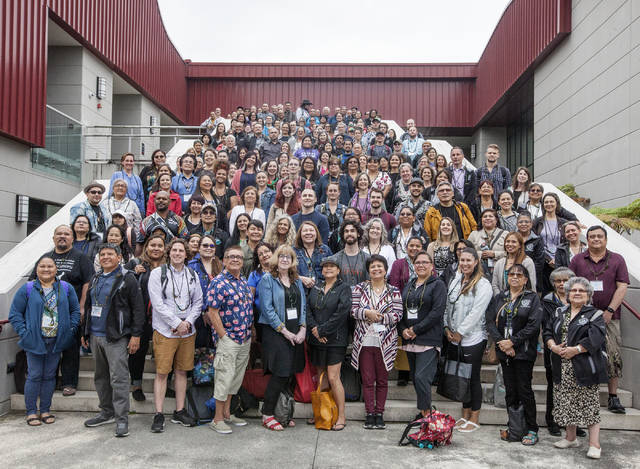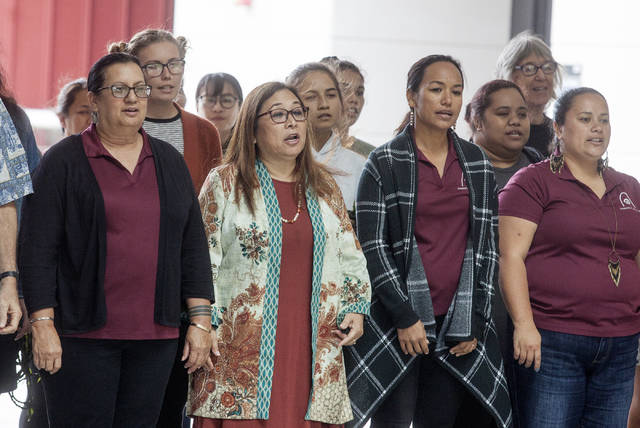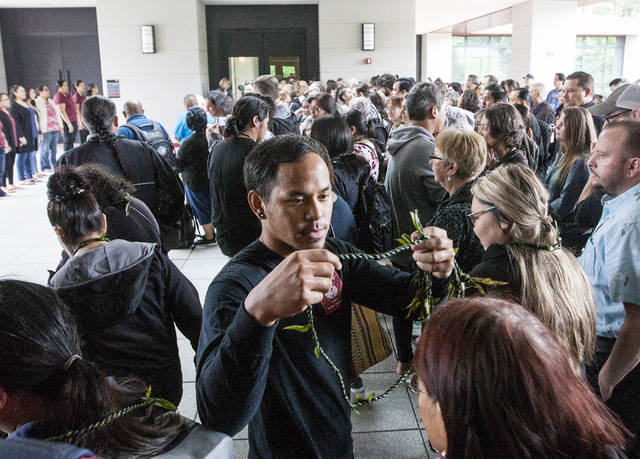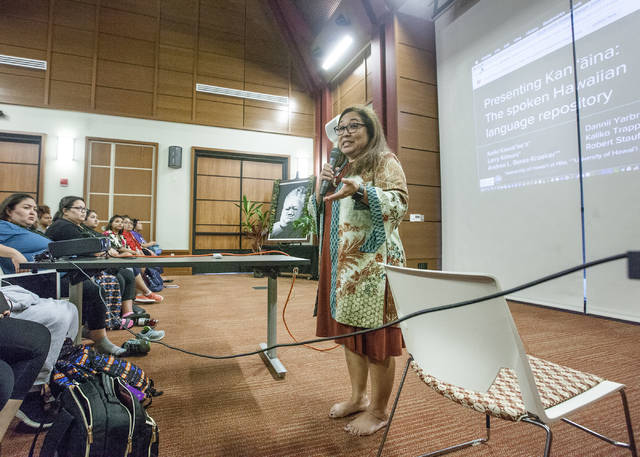Echoes of the past: Spoken-language digital repository created for Hawaiian language

Participants pose for a group shot Monday during the He Olelo Ola Hilo Field Study conference, Lono Ae I Na Leo Kupuna - Hearing Ancestral Voices at University of Hawaii at Hilo.


Nakamakanikolonahe Obrero gives lei to participants of the He Olelo Ola Hilo Field Study conference. (Photos by HOLLYN JOHNSON/Tribune-Herald)

Director of KH’UOK College Keiki Kawai’ae’a speaks about the launch of Kani’aina, “Voices of the Land,” Monday during the He Olelo Ola Hilo Field Study conference, Lono Ae I Na Leo Kupuna - Hearing Ancestral Voices at University of Hawaii at Hilo. (HOLLYN JOHNSON/Tribune-Herald)
HILO The voices of Hawaiis past will be preserved for the Hawaiian languages future, thanks to the launch last week of a new spoken-language digital repository.
HILO — The voices of Hawaii’s past will be preserved for the Hawaiian language’s future, thanks to the launch last week of a new spoken-language digital repository.
The first such repository of the language spoken by native speakers — Kani‘aina, “Voices of the Land” — is a collaboration between the University of Hawaii’s Ka Haka ‘Ula O Ke‘elikolani College of Hawaiian Language, digital library and archiving specialists at the UH-Manoa’s Department of Linguistics and Kaipuleohone UH Digital Language Archive.
According to the Kani‘aina website, it is an educational resource that provides interactive access to Native Hawaiian speech and transcripts through a bilingual digital library.
Kani‘aina officially launched March 4 at the He ‘Olelo Ola Hilo field study at KH‘UOK. The conference was part of the of the sixth International Conference on Language Documentation and Conservation held last month at the University of Hawaii at Manoa; the field study provided first-hand experience of the Hawaiian language revitalization efforts.
Hawaiian was the predominant language in Hawaii at the turn of the 19th century, but by 1985, there were fewer than 50 minor age native speakers of the language, the Kani‘aina site states.
But Keiki Kawai‘ae‘a, director of Ka Haka ‘Ula O Ke‘elikolani College, said there are probably 20-30 native speaking kupuna left.
“They really are our gap generation because (my) grandparents’ generation that were the last of our native speakers,” she said.
But many from her father’s generation, what she calls the gap generation, may have heard Hawaiian in the home but didn’t grow up with Hawaiian as their first language.
“So we have very few of them,” Kawai‘ae‘a said. “That is our resource, the last of our resource.”
In the last 30 years there have been efforts to revitalize the language, but Kawai‘ae‘a said most speakers, like herself, are second-language speakers.
There are a growing number of families who are raising their children with Hawaiian as a first language, she said.
“We might have heard our grandparents speaking (Hawaiian), but we were not considered native speakers,” she said. “We went to school to learn Hawaiian. Then we decided to raise our children in Hawaiian, so we had to take that dive. So the kind of Hawaiian that children are learning is a Hawaiian of a different generation. I’m not going to say it’s not Hawaiian, because it is, but it’s different than the old folks that lived in Hawaii, that grew up with (Hawaiian as) their first language, that grew up in a community that only spoke Hawaiian … We had to create new communities of speakers.”
With the new repository, Kawai‘ae‘a said they wanted a place to gather resources, where people can go and hear “native speech in its natural setting.”
The first audio collections now available on the website come from Ka Leo Hawaii, a Hawaiian-language radio program that aired from 1972-1988 and was hosted by Larry Kimura, an associate professor of Hawaiian language and culture at UH-Hilo.
According to Kimura, the program was conducted entirely in Hawaiian.
“We were fortunate and privileged to record among Hawaii’s last fluent Native Hawaiian speakers,” those who were among the last to learn through traditional means of passing down the language — mouth-to-mouth through family.
“My own grandparents didn’t pass (the language) down to us,” he said. “They could have, but it was a colonized mind at that time. The American dream, the English language was the way to go.”
Kimura said there are repositories of documents, newspapers and books, but “it’s very important to hear language, not to see it or read it. We have the pitches, the tones, the cadence, the emotions, the feelings that come through,” which is difficult to emphasize in writing.
In the future, the site will include a “crowd sourcing” component where the public can log in to help transcribe the recordings.
The recordings and transcripts will be preserved on the Kaipuleohone, UH’s digital language archive.
Original recordings and transcripts need to be protected and “we’re basically going to be holding those digital files in the University of Hawaii at Manoa’s repository, which means they’re going to be safe, they’re going to be a master copy for the long-term,” said Andrea Berez-Kroeker, an associate professor in the UH-Manoa Linguistic Department.
Visit the Kani‘aina site at ulukau.org/kaniaina.
Email Stephanie Salmons at ssalmons@hawaiitribune-herald.com.


